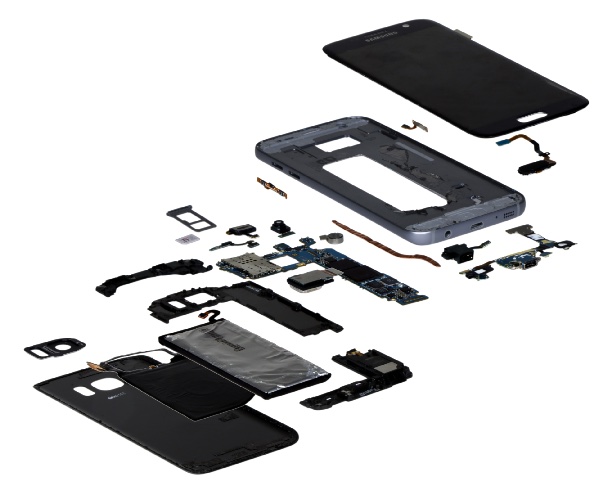Samsung Galaxy S7 IHS Teardown Reveals Ho-Hum Refresh – Costs More, Depreciates Faster, Than iPhone 6s
A preliminary estimate by IHS Inc. and its Mobile Handsets Intelligence Service shows the Samsung Galaxy S7 smartphone costs about $255 to build. The U.S. version of the Galaxy S7 with 32 gigabytes (GB) of NAND memory carries a bill of materials (BOM) of $249.55, which rises to $255.05 when the manufacturing cost is added, according to results from the IHS teardown of a phone purchased from Verizon. The retail price of the Galaxy S7 at Verizon is $672. As another point of reference, Apple’s 16GB iPhone 6s has a BOM of $187.91 and retails for $649.
“The Galaxy S7 is the upgrade Samsung had to do, but theres not a lot of trailblazing happening on the device,” says Andrew Rassweiler, senior director of cost benchmarking services at IHS. Its more a case of small refinements. Samsung is spending more and more on its bill of materials, but theyre selling something that doesn’t hold its price as well as an Apple product. Samsung’s S7 BOM is almost $60 more than a comparable iPhone.
Same Diagonal, Same Resolution
The IHS teardown revealed not much change on the display front from the prior generation phone. The S7’s Samsung-manufactured 5.1-inch Quad HD Super AMOLED touchscreen display is the same size and resolution (2560×1440 pixels, 577 PPI) as the S6 and costs $55. According to the latest IHS Smartphone Display Market Tracker, AMOLED displays have price eroded on average 4 percent quarter-on-quarter over the last three quarters.
Fastest Chipset in a Smartphone to Date
Found in the Verizon S7 sample torn down by IHS is Qualcomm’s latest and greatest silicon, the Snapdragon 820, which offers generational improvements over the S6s Snapdragon 810. The new chipset affords better power efficiency, faster battery charging and includes a speedier data bus that supports LPDDR4 memory with a capacity up to 4GB — the highest density to date in a smartphone. The Snapdragon 820 is capable of supporting LTE CAT-12, which provides 33 percent faster theoretical data throughput than the CAT-9 capabilities of the Snapdragon 810 (600 Mbps versus 450 Mbps). IHS puts the entire cost of the Qualcomm chipset solution (Snapdragon 820 and other Qualcomm supporting components) at $62, giving Qualcomm one of the largest component supplier footprints on the S7 BOM from a dollar perspective.
Flash Memory Getting Cheaper and Cheaper
The Samsung NAND flash memory found on the S7 is 32GB and comes in at a cost of $7.25. Mr. Rassweiler notes that: “Cost per gigabyte is becoming incredibly low in NAND flash, giving rise to higher mass storage and solid-state drive adoption rates. And we expect even greater price erosion in the future, as new flavors of NAND flash like Samsungs 3D VNAND penetrate the market and get scale.”
“DRAM, or dynamic random access memory, on the S7 is from SK Hynix and is of the LPDDR4 4GB package-on-package (PoP) flavor. IHS estimates its price tag at $25. LPDDR4 has become the new de facto standard for smartphone DRAM. Samsung and other Qualcomm apps processor-based designs typically feature more memory than Apple designs. The iPhone 6s has only 2GB of LPDDR4 DRAM,” Mr. Rassweiler continues.
Fewer Megapixels = Best Camera in a Smartphone
For the S7 camera, the IHS teardown found that Samsung backtracked on camera pixel inflation in favor of technology improvements that deliver better overall camera performance. The S7 features a 12 megapixel (MP) primary camera module, whereas the S6 had a 16MP module. The camera module features a 1.4m-pixel-based image sensor equipped with dual pixel technology for faster autofocus capability, improved image quality in low-light situations and deep trench isolation for less pixel crosstalk. The front-facing camera is 5MP.
“Going backwards from 16 megapixels to 12 megapixels buys Samsung larger pixel sizes for better low-light performance,” explains Wayne Lam, principal analyst for mobile devices and networks at IHS. “HTC did this a while ago with the One Design, but they went down to four megapixels and, as a result, it did poorly in the marketplace. But the S7 boasts arguably the best camera on the market right now.”
Bigger Battery, Cooler Design and the Return of Expandable Storage
While Samsung is offering only a 32GB version of the Galaxy S7 in the US25GB of which is user accessible, it has brought back microSD expandable storage that accepts cards of up to 200GB.
A step up from the S6’s IP67 rating, the S7 has a water resistance rating of IP68, indicating it is water resistant in up to five feet of water for up to 30 minutes. The IHS teardown revealed silicone seals and sealed components throughout the phone design to inhibit water ingress.
The S7 features a beefier 3000mAh Li-Polymer battery than the 2600mAh found in the S6, likely to handle the phones higher processor performance and provide improved battery life. The battery is a fast-charge type and supports wireless charging.
The teardown revealed a copper heat exchanger for thermal management. A design feature typically only found in notebook and desktop PCs, heat exchangers have only been seen in one other smartphone, the Nokia Lumia.
On the sensor front, the S7 includes the usual accelerometer, gyroscope, compass, fingerprint sensor, pressure (barometer) sensor and optical pulse sensor. The sensors add $4.65 to the cost of the phone.
The Teardown and Cost Benchmarking Service from IHS provides complete, detailed analysis of electronicsfrom small devices such as wireless handsets and tablets to larger equipment such as servers and automotive infotainment systemsdelivering a comprehensive assessment and cost breakdown of all electronic, electro-mechanical and mechanical components. IHS analysts have performed more than 2,500 teardowns, identifying and pricing over 3 million components and taking over 90,000 teardown photos.
For more information, visit:
http://www.ihs.com
Source: IHS Inc.

